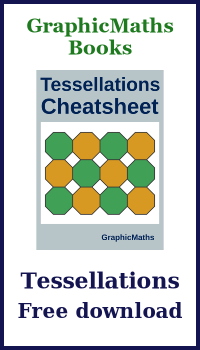Parallel lines
Categories: gcse geometry
Level:

Here are some basic geometry rules about parallel lines. They are also covered in this video:
Angles around intersection lines
When two lines intersect, four angles are formed:
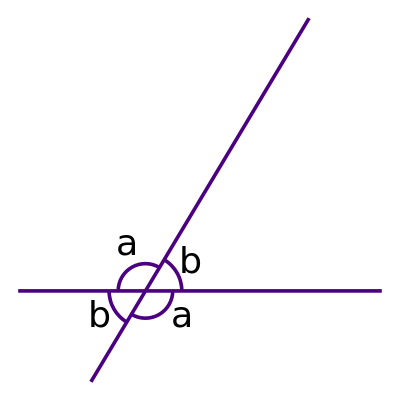
The angles around intersecting lines form two pairs of opposite and equal angles. The two angles labelled a are equal, and the two angles labelled b are equal. This means that there are only two different angles at the intersection.
Since angles a and b form a straight line, we also know that:
a + b = 180°
Angles around parallel lines
If we draw an extra line, parallel to the previous line, it looks like this:
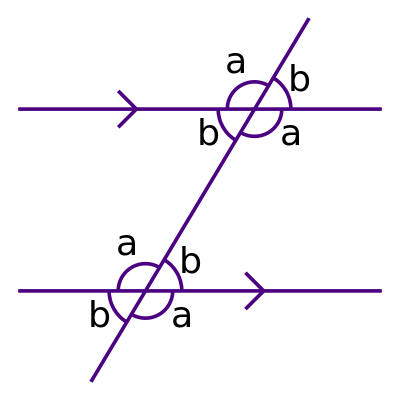
The small arrows on the two horizontal lines indicate that they are parallel with each other.
Since the lines are parallel, they both make the same angle with the line that crosses them. So both intersections only involve the two angles a and b. This means that if we know the value of any angle, we can find out all the other angles. For example, if we are told that a is 120°, we know that all the angles labelled a in the diagram are 120°. We can then calculate that b is 60° (since a + b is 180°), so we know all the angles.
There are several common cases of matching pairs of angles around pairs of angles. These are given special names - alternate angles, allied angles, and corresponding angles.
Alternate angles
If you take one of the angles from the first intersection and the opposite angle from the second intersection, they are called alternate angles:
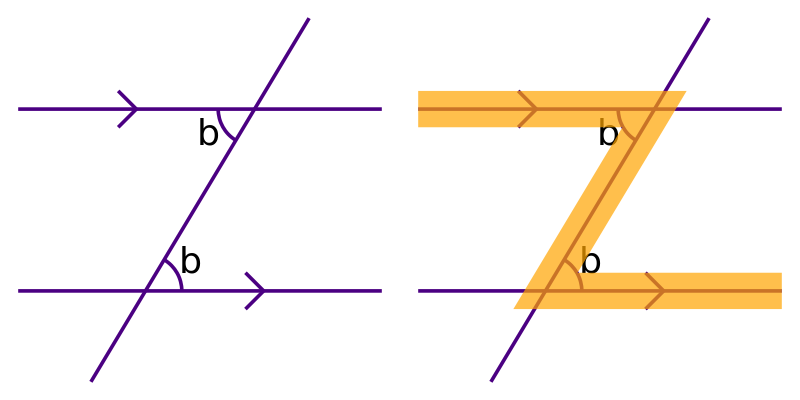
Alternate angles are equal. In this case, the angles are both equal to b.
The diagram shows that you can spot alternate angles by a characteristic Z shape. But the shape might be rotated or flipped, so it might not always look exactly like a Z. Here is an example of a different pair of alternate angles:
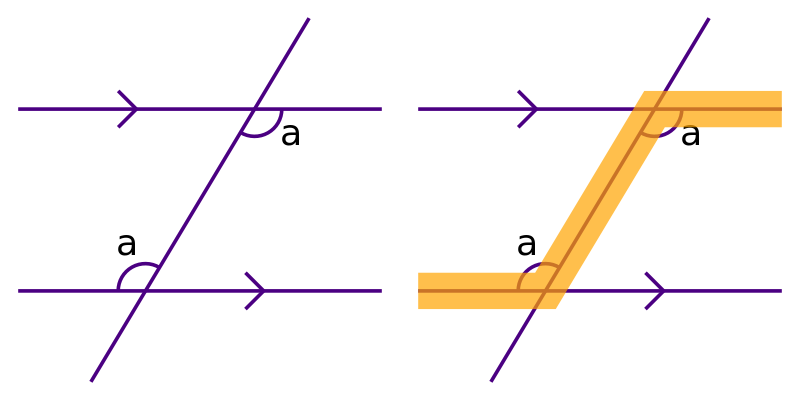
Allied angles
You could think of the intersection as being one half of a parallelogram:

Allied angles are the two "internal" angles in that half of the parallelogram:

Allied angles add up to 180°. We can see this because there will always be one a and one b angle.
Allied angles are sometimes called co-linear angles or internal angles.
The diagram shows that you can spot allied angles by a characteristic C shape. The shape might be rotated or flipped, so it might not always look exactly like a C. Here is an example of a different pair of allied angles:
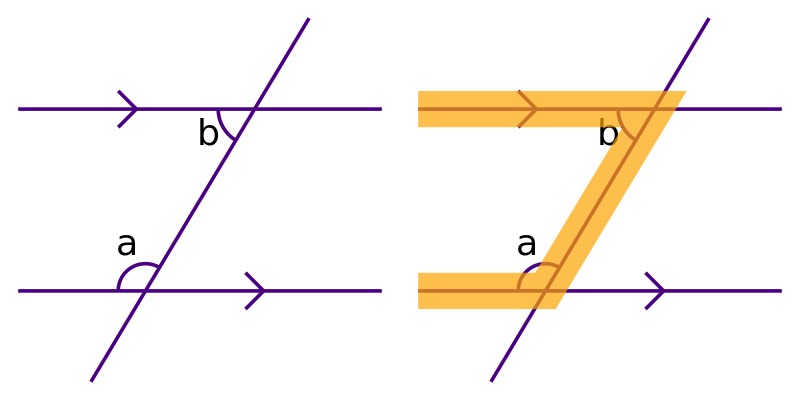
Corresponding angles
If you take one of the angles from the first intersection and the equivalent angle from the second intersection, they are called corresponding angles:
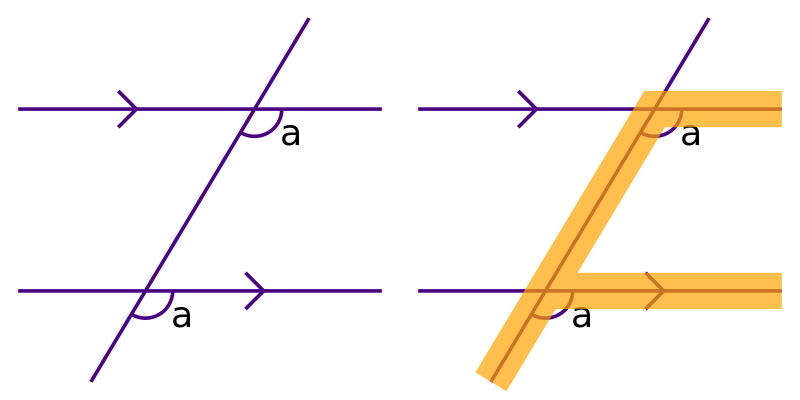
Corresponding angles are equal. In this case, the angles are both equal to a.
The diagram shows that you can spot corresponding angles by a characteristic F shape. Again, the shape might be rotated or flipped, so it might not always look exactly like an F. Here is an example of a different pair of corresponding angles:
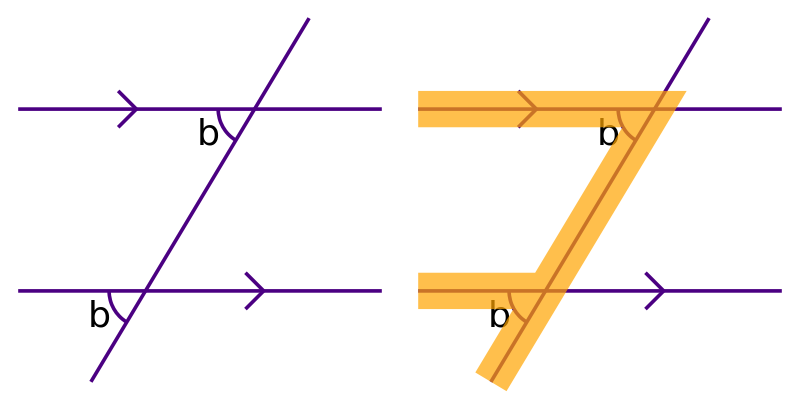
Testing for parallel lines
We have seen how we can use the rules of parallel lines to find unknown angles in pairs of parallel lines. But there is also something else we can do. We can use known angles to prove that two lines are parallel. This diagram shows two horizontal lines that may or may not be exactly parallel, intersected by a third line:

The angles around the point on the lower line are c and d. The angles around the point on the lower line are e and f.
If the two lines are parallel, then, using the alternate angle rule:
c = e and d = f
But the opposite is also true. If the two lines are not parallel, then those two pairs of angles will not be equal:
c ≠ e and d ≠ f
But also, by the allied angle rule, if the two lines are parallel, then:
c + f = 180° and d + e = 180°
Again, the opposite is also true. If the two lines are not parallel, then:
c + f ≠ 180° and d + e ≠ 180°
This means that two lines will be parallel if and only if any of the following are true:
c = e or d = f or c + f = 180° or d + e = 180°
And if any of those statements are true, they will all be true.
Join the GraphicMaths Newsletter
Sign up using this form to receive an email when new content is added to the graphpicmaths or pythoninformer websites:

Popular tags
adder adjacency matrix alu and gate angle answers area argand diagram binary maths cardioid cartesian equation chain rule chord circle cofactor combinations complex modulus complex numbers complex polygon complex power complex root cosh cosine cosine rule countable cpu cube decagon demorgans law derivative determinant diagonal directrix dodecagon e eigenvalue eigenvector ellipse equilateral triangle erf function euclid euler eulers formula eulers identity exercises exponent exponential exterior angle first principles flip-flop focus gabriels horn galileo gamma function gaussian distribution gradient graph hendecagon heptagon heron hexagon hilbert horizontal hyperbola hyperbolic function hyperbolic functions infinity integration integration by parts integration by substitution interior angle inverse function inverse hyperbolic function inverse matrix irrational irrational number irregular polygon isomorphic graph isosceles trapezium isosceles triangle kite koch curve l system lhopitals rule limit line integral locus logarithm maclaurin series major axis matrix matrix algebra mean minor axis n choose r nand gate net newton raphson method nonagon nor gate normal normal distribution not gate octagon or gate parabola parallelogram parametric equation pentagon perimeter permutation matrix permutations pi pi function polar coordinates polynomial power probability probability distribution product rule proof pythagoras proof quadrilateral questions quotient rule radians radius rectangle regular polygon rhombus root sech segment set set-reset flip-flop simpsons rule sine sine rule sinh slope sloping lines solving equations solving triangles square square root squeeze theorem standard curves standard deviation star polygon statistics straight line graphs surface of revolution symmetry tangent tanh transformation transformations translation trapezium triangle turtle graphics uncountable variance vertical volume volume of revolution xnor gate xor gate
